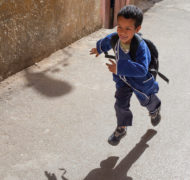A Back-to-School Assignment for the Rest of Us
Blog / Produced by The High Calling
Does your Facebook look like mine? Photograph after photograph of happy children in new sneakers, sporting new backpacks, and holding signs marking their first day of school in a new grade. Their parents are hopeful and proud.
Back to School doesn’t look like this for everyone.
Consider the students in Pinellas County, Florida, whose schools were dubbed “Failure Factories” by the Tampa Bay Times. That was the headline. Here’s the hook:
“In just eight years, Pinellas County School Board members turned five schools in the county’s black neighborhoods into some of the worst in Florida.”
The article goes on to outline some of the key actions (or, inaction) taken by the Pinellas County School Board:
“First they abandoned integration, leaving the schools overwhelmingly poor and black.
“Then they broke promises of more money and resources.
“Then—as black children started failing at outrageous rates, as overstressed teachers walked off the job, as middle class families fled en masse—the board stood by and did nothing.”
It Takes Courage to Face the Truth
So, what about the parents whose children are students in Pinellas County, Florida? Are they hopeful? Are their children happy?
Ask a few parents today, and they’ll probably tell you they believe every child should have access to a quality education. Poor children too often receive a poor education. And, as This American Life’s two-part podcast “The Problem We All Live With” showed us, abandoning efforts to desegregate schools also serves to widen the achievement gap. Consider just a few of the facts from DoSomething.org:
40 percent of children living in poverty aren’t prepared for primary schooling,
16- to 24-year-old students who come from low-income families are seven times more likely to drop out than those from families with higher incomes, and
fewer than 30 percent of students in the bottom quarter of incomes enroll in a four-year school. Among that group—less than 50 percent graduate.
Three Promises Christians Can Keep
In the face of such significant statistics, what can we do? As people of faith, we are the hands and feet of Jesus in the world, so where—and how—do we step in? While our children and grandchildren and neighborhood children head back to school, what about the rest of us? What small things can we do to serve those students, teachers, and schools in our counties, that struggle against the odds? Here are a few suggestions:
- Be present. Find out what’s going on in your county schools. Attend school board meetings, and vote when elections are held.
- Be helpful. If your community’s schools are thriving, find out where the schools are that need your help. Volunteer in those schools that are struggling; get to know the teachers, the students, and their parents. Check out The Expectations Project to learn how your congregation might partner with the 48,990 high poverty public schools in our country and help “change the face of education inequality.”
- Be honest. If you’ve forgotten that God calls us to advocate for and serve those who need our help, confess that to God. Then, ask him to show you ways to be present and helpful, as salt and light, in those struggling schools near you.





